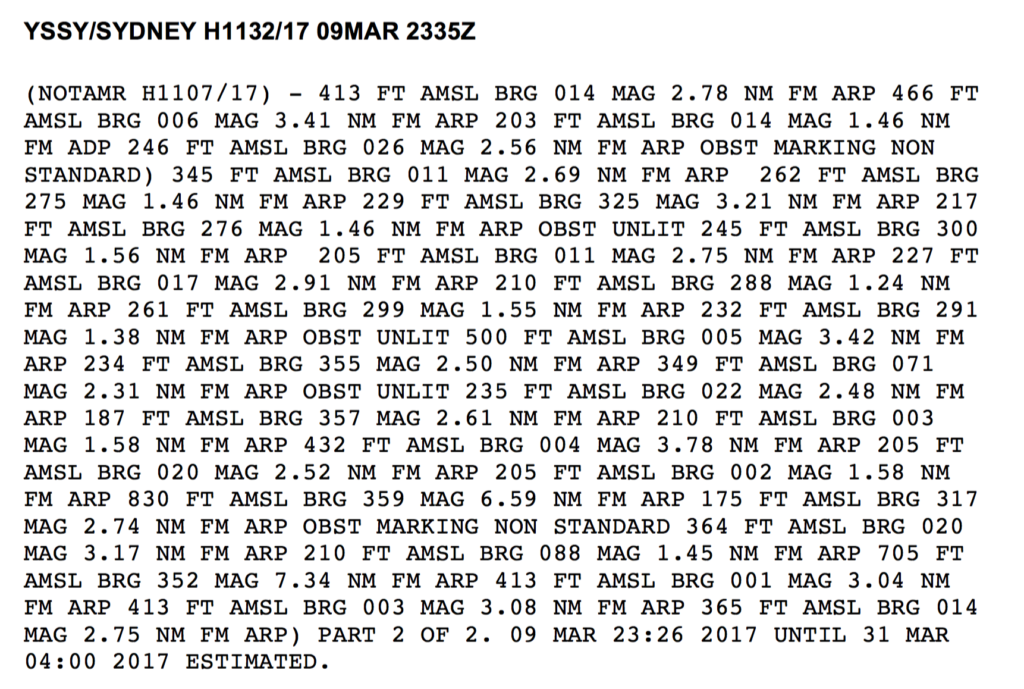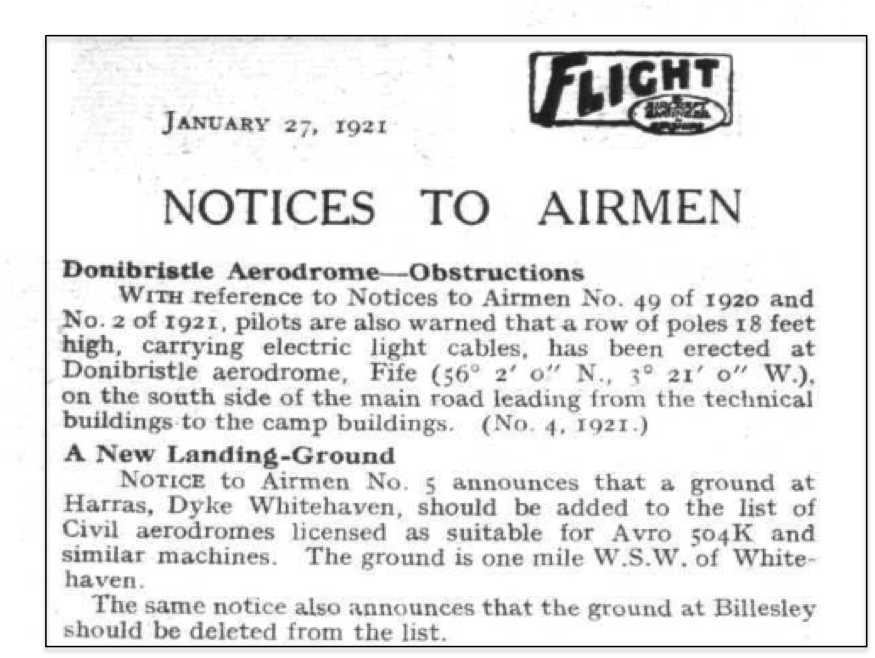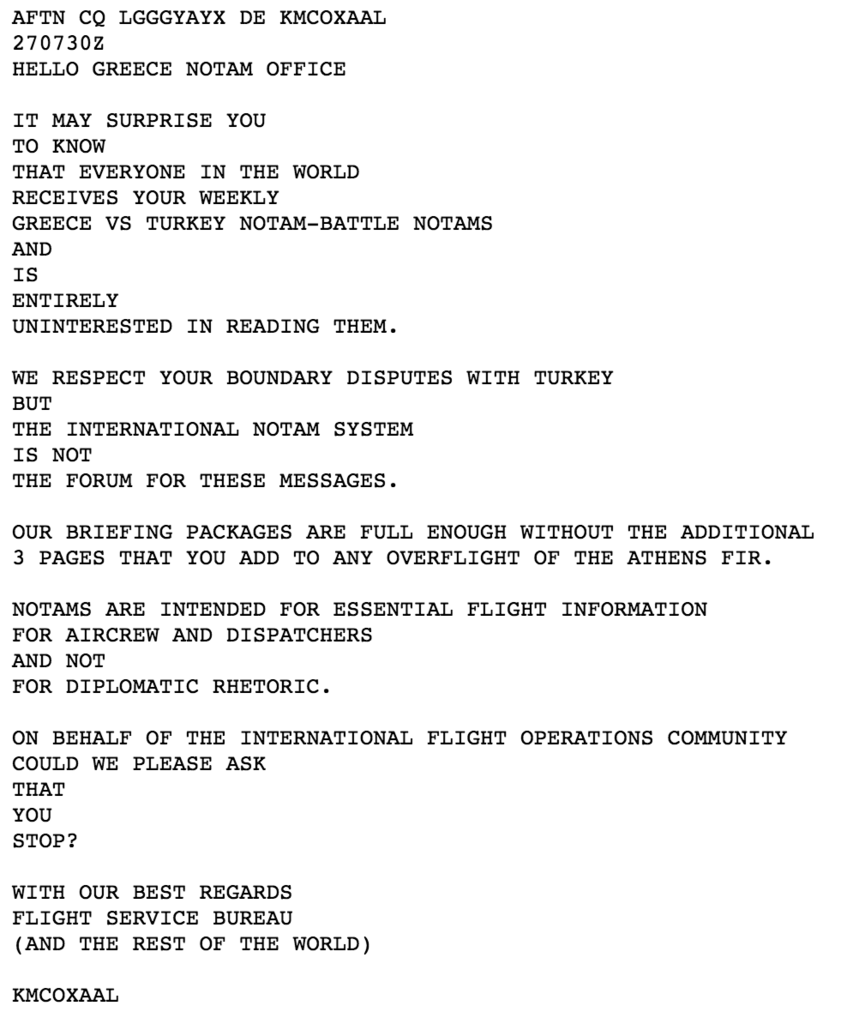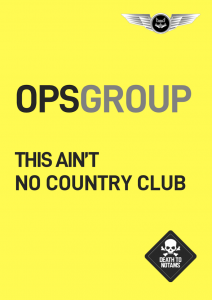This article was first published on our blog in March 2017. It’s become a defining mission of the group to fix this problem.
It’s absolutely ridiculous.
We communicate the most critical flight information, using a system invented in 1920, with a format unchanged since 1924, burying essential information that will lose a pilot their job, an airline their aircraft, and passengers their lives, in a mountain of unreadable, irrelevant bullshit.
Yes CASA Australia, that’s you. Yes, Greek CAA, that’s you. And you’re not alone.

In an unintended twist of irony, the agencies seeking to cover their legal ass are party to creating the most criminal of systems – an unending flow of aeronautical sewage rendering the critical few pieces of information unfindable.
This is more than just hugely frustrating for each pilot, dispatcher, and controller that has to parse through it all; it’s downright dangerous.
If you’re a pilot, you’ll either have already experienced this, or you’re going to – you stuff something up, and then be told: “but there was a Notam out about that”. Sure enough, there it is in black and white (and in big capital letters). Do you think that “but there were 100 pages of them” is going to be a valid defence?
Well, it should be. The same agency conducting your post-incident interview is busy on the other end stuffing the system full of the garbage that prevented you from seeing it in the first place.
There are three parts to the problem: the system, the format, and the content. The system is actually quite amazing. The AFTN network connects every country in the world, and Notam information once added is immediately available to every user. Coupled with the internet, delivery is immediate.
The format is, at best, forgivable. It’s pretty awful. It’s a trip back in time to when Notams were introduced. You might think that was the 1960’s, or the 50’s. In fact, it’s 1924, when 5-bit ITA2 was introduced. The world shifted to ASCII in 1963, bringing the Upper and Lower case format that every QWERTY keyboard uses today, but we didn’t follow – nope, we’ll stick with our 1924 format, thank you.
Read that again. 1924. Back then, upper case code-infested aeronautical messages would have seemed impressive and almost reassuring in their aloofness. But there weren’t in excess of 1 million Notams per year, a milestone we passed in 2013. The 1 million milestone is remarkable in itself, but here’s something else amazing: in 2006, there were only 500,000. So in seven years, Notams doubled. Why? Are there twice as many airports in the world? No. Twice as many changes and updates? Possibly. But far more likely: the operating agencies became twice as scared about leaving things out.
And so onto the culprit: the content. The core definition of a Notam is ESSENTIAL flight information. Essential, for anyone tasked with entering information into the Notam System, is defined as “absolutely necessary; extremely important”. Here’s a game you can play at home. Take your 100 page printout of Notams, and circle that ones that you think can be defined as essential. See how many fit that bill.
So why is all this garbage in the system? Because the questions that the creators of Notams ask are flawed. The conversation goes like this:
– “Should we stick this into a Notam?”
– “Yeah, we’d better, just in case”.
How many are actually asking, “Is this essential information that aircrew need to know about ?”. Almost none. Many ‘solutions’ to the Notam deluge involve better filtering, Q codes, and smart regex’s. This overlooks the core problem. It’s not what comes out that needs to be fixed, it’s what goes in.
Even in 1921, we had much the same problem. Obstacle, 18 feet high, several miles from the runway.

Nobody cares. Unless you’ve parked the Eiffel Tower on the threshold, leave this stuff for the AIP. And nobody cares about kites either. Nor about goat-grazing times. We don’t care if your bird scarer is U/S. We don’t care if there’s a cherry-picker fixing a bulb somewhere. We don’t care when you’re cutting your grass.
Nor do we care about closed taxiways. The only way I can get onto a taxiway is with an ATC clearance, and ATC will not clear me onto a closed taxiway.
We care if the airport is going to be closed when we get there. If we’re going to have to divert because the runway is shut. If someone might shoot at us. If there are new rules. We care about the critical items, but we won’t see them as things stand.
And so, about here is where a normal editorial piece might end with “we hope that the authorities improve the system”, and sign off.
But not here.
We’re in the business of doing things here at FSB, not just talking about them.
Last year we wrote a few pieces about the Greece vs Turkey Notam battle. This month we did a group look at Briefing Packages, and it was astonishing to see how many pages of this diplomatic drivel still appeared in all our members’ Briefings. All in all, on average 3 full pages of every briefing for a flight overflying Greece or Turkey contained this stuff.
So, we sent Greece a polite AFTN message on behalf of all of us.

That’s just one piece of a thousand-piece puzzle, and it would be nice to think that one piece at a time we could fix the sytem. Let’s get real. It’s a monster, and it’s out of control.
We don’t think that we can fix the Notam system.
But, we can think about a different solution. And that’s exactly what we’re doing right now in OpsGroup. With almost 2000 members, we can make a difference. Watch this space. Or, if you want to help take action, send your thoughts to goatams@ops.group.


